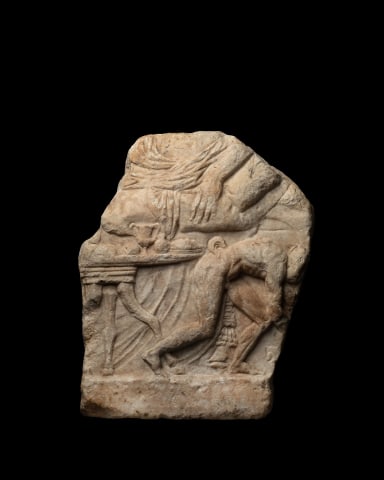Icarius reliefs depict Dionysos, who was patron of the theatre, visiting Icarius, the father of Attic tragedy (or sometimes another poet). Margarete Bieber discusses this genre, and states that the reliefs are particularly noteworthy for their inclusion of a foreground set against a continuous pictorial background.
Provenance
Joseph von Kopf (1827-1903), Rome, Italy
Hagop Kevorkian (1872-1962), New York, USA; thence by descent to the Hagop Kevorkian Fund
Hanita (1915-2019) and Aaron (1918-2000) Dechter, USA; acquired 22nd November 1974
Collection number in blue crayon '142'
Hagop Kevorkian was an Armenian-American, an art connoisseur, collector and archaeologist. After his death, his foundation established the Kevorkian Chair of Iranian Studies at Columbia University. The Hagop Kevorkian Center for Near Eastern Studies at New York University was created in 1966 to encourage the study of the contemporary Middle East.
Exhibitions
University Art Gallery, California State University, San Bernardino, May 5-June 2, 1989; Art Galleries, California State University, Northridge, February 26-March 30, 1990, object number 6
Literature
Compare an identical example from the British Museum, published in Margarete Bieber, The Sculpture of the Hellenistic Age (New York, 1967), fig.656 and pp.153-154
Publications
Ludwig Pollak, Joseph v. Kopf als Sammler: Beschreibung der von ihm hinterlassenen Sammlung (Rome, 1905), p.6, no.17, pl.4Sotheby Parke-Bernet, New York, Antiquities, 22nd November 1974, lot 248 'Property of the Hagop Kevorkian Fund'
Kenneth Hamma, ed., The Dechter Collection of Greek Vases (San Bernardino, 1989), p.83, no.6